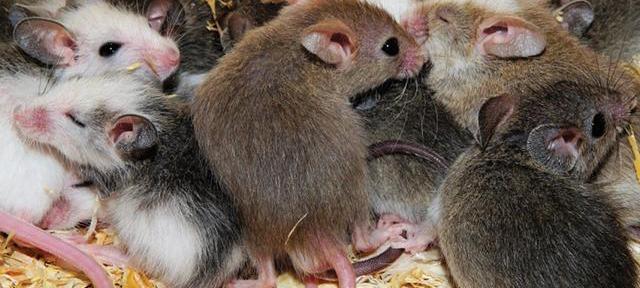Why Do Mice Horse Around?

For Miranda Harrison, play is a serious topic.
She traveled to Tinjil Island, in Indonesia, to study the sexually differentiated toy preferences of a local monkey, the long-tailed macaque, and spent long hours encouraging the Hampshire Farm’s resident boar, Duke, to play with a giant Kong dog toy in his pen to see if play could decrease his levels of stress and anxiety.
Her Division III project explores the connection between sex hormones and play behavior using genetically altered “knockout mice.”
Harrison designed a complex study involving the play behaviors of a strain of genetically altered juvenile mice, titled Sex Steroid Receptor Genes & Agonistic Play Behaviors of Prepubertal TRPC2 Knockout Mice.
“I’ve done quite a bit of play research,” Harrison says. “There’s been some debate about how to understand what the function of play is and how to define ‘play’ for animals. I see it as training for adult behavior.”
Specifically, Harrison studies play as a means of understanding the effects of sex hormones (testosterone, estrogen, and progesterone) on brain formation and behavior.
Her Div III committee was chaired by Jane Couperus, dean of the School of Cognitive Science and associate professor of developmental cognitive neuroscience; Laela Sayigh, visiting assistant professor of animal behavior also served on the committee.
Harrison devised a research study that assesses the level of aggression in the play fighting of two strains of juvenile mice — one that could scent pheromones and one that could not. Pheromones are chemical signals released into the environment to provide information such as sex and social ranking. Pheromonal cues trigger behavioral and endocrine responses, and the latter dictate levels of aggression.
To conduct the study, Harrison had to create her own research team. She recruited Div I and Div II students, taught them how to use Finnish software designed to code the videotaped behaviors of animals (the mice), wrote grant proposals to fund her work, performed statistical analyses, and refined research protocols.
The genesis of her Div III occurred during the summer of 2018, when Harrison worked at Michigan State University as a research assistant in a behavioral neuroscience lab that studies the effects of steroid hormones on the developing and adult nervous system. The subject of one of the lab’s studies was olfactory-challenged TRPC2 knockout mice.
“The vomeronasal organ enables the mice to scent pheromone signals,” explains Harrison. “Scenting pheromones triggers an endocrine response. Without them, the knockout mice presumably have no information on the sex and social status of the mice around them.”
As a result, the male mice mounted other males and became less aggressive toward them. Female mice would perform male courtship behaviors. Without the release of pheromones, behaviors that once differentiated males and females became less distinct.
Back at Hampshire, Harrison decided to find answers to some of the questions her work at MSU had raised. One was whether there would there be differences in aggression between the play of male juvenile TRPC2 mice and the play of peers able to detect pheromones. This question became the basis of her Div III project.
Ultimately, Harrison aims to push forward our understanding of hormonal influences on animal and human behavior.
“We’re all hormonal cocktails,” she says. “There’s is a huge and sometimes contradictory continuum of male and female on the spectrum of sex.”
Hampshire supported Harrison’s research with numerous grants, among them one from the Ray and Lorna Coppinger Endowment for $2,800 that funded her study at MSU and her travel to a conference in Toronto to give a poster presentation that summer. The Coppinger fund granted her an additional $4,000 to cover costs related to her Div III research. In all, Harrison has received some $12,000 in grants from Hampshire, including gifts from the Culture, Brain, and Development Fund, the Cognitive Science Fund, and the Justine Salton Memorial Fund.
That type of support for independent research was exactly why Harrison transferred to Hampshire in fall 2017. She left a more traditional college because she found the lack of interdisciplinary opportunities and the rigid boundaries of academic majors stifling.
“At Hampshire, I was able to create a Franken-major that combined study of psychology, animal behavior, neuroscience, and gender studies,” she says. “The College completely let me create my own path.”



